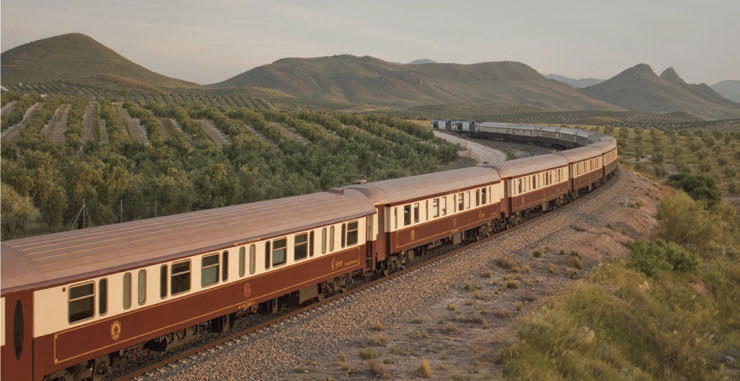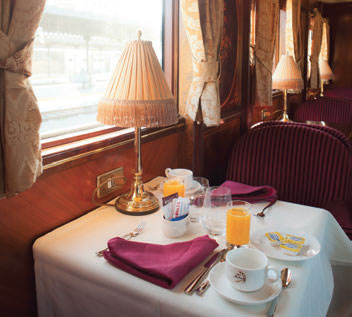Combining timeless sophistication and contemporary comforts, luxury train journeys are for many inveterate travellers the only way to enjoy a truly tranquil, stress-free holiday break. With airport security measures becoming increasingly onerous, traffic congestion on the roads causing extreme exasperation during peak seasons and most cruise ships packed with enough people to inhabit a small city-state, the lure of a leisurely expedition chugging through the countryside while enjoying silver-plated service is particularly appealing.
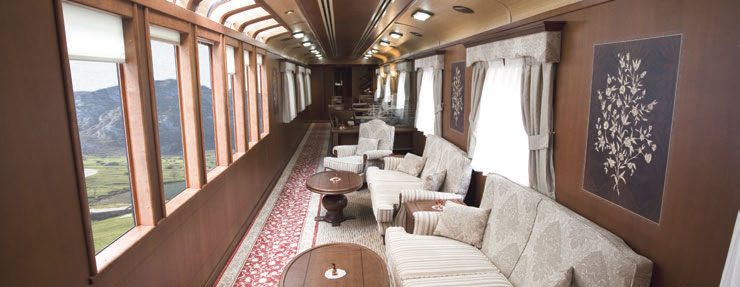
From the Trans-Siberian and Orient Express in the Northern Hemisphere to the
Indian Pacific and Pride of Africa in the south – and many memorable journeys
in between – the world is criss-crossed every year by stately hotels on wheels
that offer travellers old-world refinement and memorable views.
One key station on this global route is Spain, enhanced by its attraction as a
country of splendidly diverse contrasts, and powered along by two showpieces
of the Renfe fleet: the Al Andalus and the Transcantábrico.
The national rail company’s tourist train schedule for 2015 was unveiled during
an exclusive press trip on the Al Andalus from Madrid to Aranjuez, located in
the southern part of the Madrid region and one of the Crown of Spain’s “Royal
Estates” since the mid-16th century.
Home & Lifestyle travelled to and from the Spanish capital on the high-speed
AVE: a journey of less than two and half hours each way, and (at least on this occasion,
thanks to Renfe’s hospitality) enjoyed in the comfort of the train’s “Club”
and “Preferente” classes (to Madrid and return, respectively).
After boarding the Al Andalus at Madrid’s Railway Museum (well worth a visit on
its own merits), and popping the first champagne corks while admiring the vintage
glamour of a décor featuring sumptuous mahogany wood and fine marquetry,
we gently rattled our way to Aranjuez 40 kilometres away. Here the Renfe
team outlined the various options for tourist train travel this year, and invited
us to savour a taste of the five-star cuisine that travellers enjoy: Asturian cheese
assortment with quince and nuts; lobster, monkfish and Raf tomato salad with
fresh cottage cheese and oregano oil; duck confit with textured apple salad; and
fried milk with vanilla sauce and red fruits ice-cream.
Bearing in mind they had to serve 60 people simultaneously (the usual number
of passengers) and journalists can become notoriously cantankerous when hungry
(and thirsty), the service was impeccably timed and exquisitely amiable, and
the food was of the highest quality and preparation.
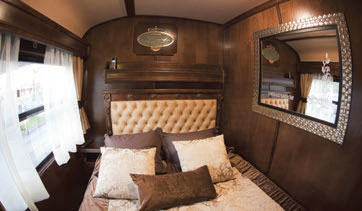
AND SO TO THE BUSINESS AT HAND…
The Al Andalus is celebrating its 30th anniversary in 2015, although the
actual train dates to the 1920s, when members of the British royal family
were among its illustrious passengers travelling from Calais to the French
Riviera.
This milestone is being celebrated with an expanded schedule of travel itineraries
and options, highlighted by the classic trip through Andalucía’s provinces
(six days/five nights), a three-day route from Granada to Sevilla (with visits to
Úbeda, Baeza and Córdoba) and four days from Sevilla to Granada (with stops
at Jerez, Cádiz and Ronda).
At the end of spring, the Al Andalus will also complete a route around Extremadura,
before heading north for a five-day journey in July between León and La
Coruña, covering famous landmarks on the Camino de Santiago and including a
visit to Santiago de Compostela.
The Transcantábrico was the first tourist rail route created in Spain over 30 years
ago, although the train is more modern than the Al Andalus – albeit just as
grandly appointed.
This year there will be two distinctive itineraries: one between San Sebastián
and Santiago de Compostela via the Cornisa Cantábrica (“Green Spain”); and the
other from León to Santiago. In order to adapt these routes to clients’ varying
requirements – i.e. shorter and less expensive – the options range from eight
days and seven nights to three days and two nights, available until October (the
first trips were in March).
In addition to the Al Andalus and the Transcantábrico, Renfe offers two other
tourist train journeys: the La Robla Express, two four-day and three-night routes
between León and Bilbao (spring and summer) and between Bilbao and Oviedo
(summer); and the Peregrino, four summer journeys from Madrid to Galicia (five
days and four nights).
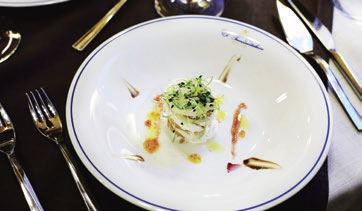
Trip File
• Slightly more than half of Renfe’s Transcantábrico and Al Andalus passengers
are from overseas, mainly Germany (23%), United States (14%), UK
(12%), Australia (10%), Switzerland (6%) and Brazil (4%).
• Renfe’s passenger services are divided into long (AVE), medium (regional
on AVE or conventional-width Avian) and short distance (Cercanías).
• Opened in 1971, when limited demand and technology meant it was only
built from Málaga to Fuengirola, the Costa del Sol route carries nine million
passengers a year.
• A study is currently being undertaken to investigate five possible options
to expand the route to the western end of the Coast.
• Projects are also earmarked to improve access (with lifts) at the Torremolinos
and Los Boliches stations.
• Within Andalucía passengers can currently travel on the high-speed
AVE from Málaga to Córdoba, and Córdoba to Sevilla. Work on a bypass
around Antequera, and 20 kilometres of new railway line near Lorca, is
currently being completed to provide an AVE link between Málaga and
Granada (due to be finished by the end of the year).
• Other “local” routes include a daily service from Málaga to Ronda (and
return), and a train service to El Chorro for those wanting to walk along
the recently re-opened Caminito del Rey.
www.renfe.com / www.renfe.com/trenesturisticos
